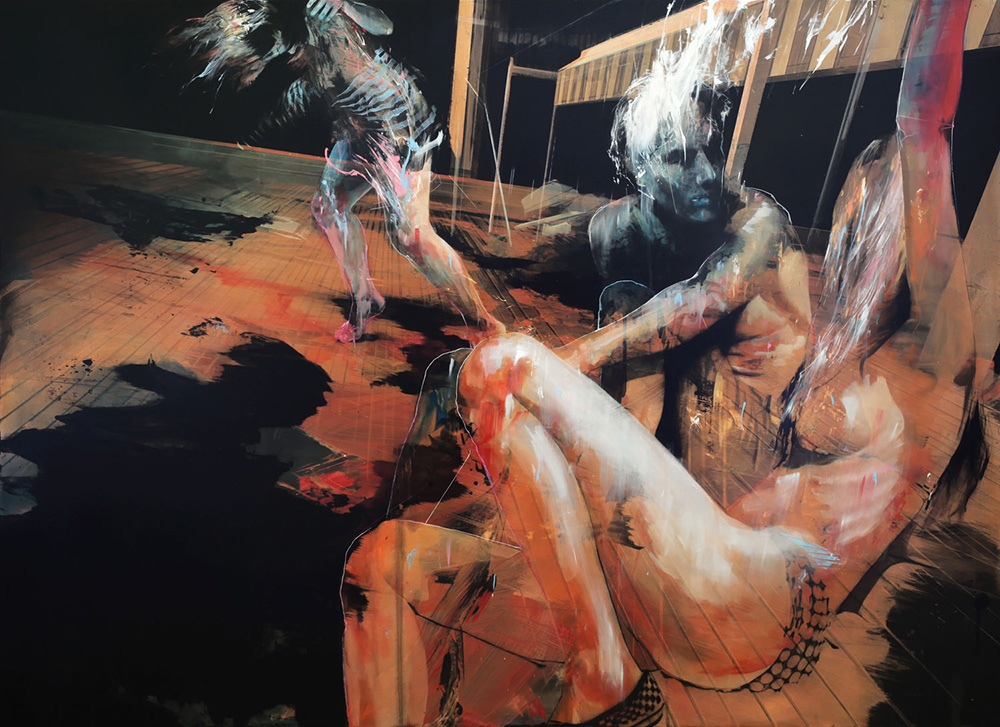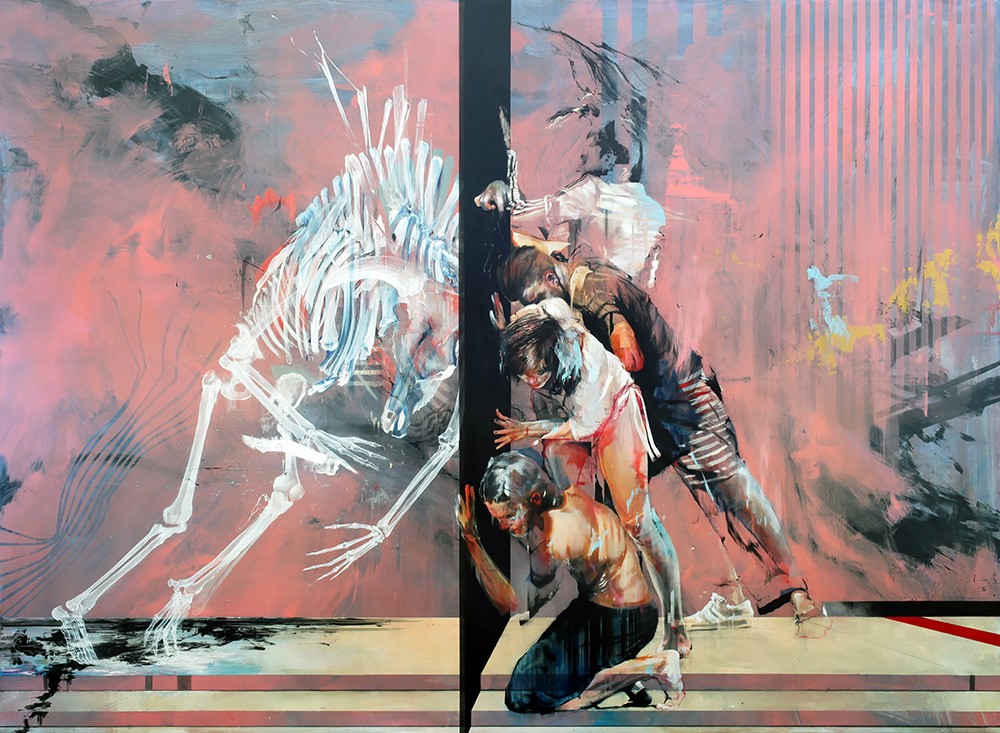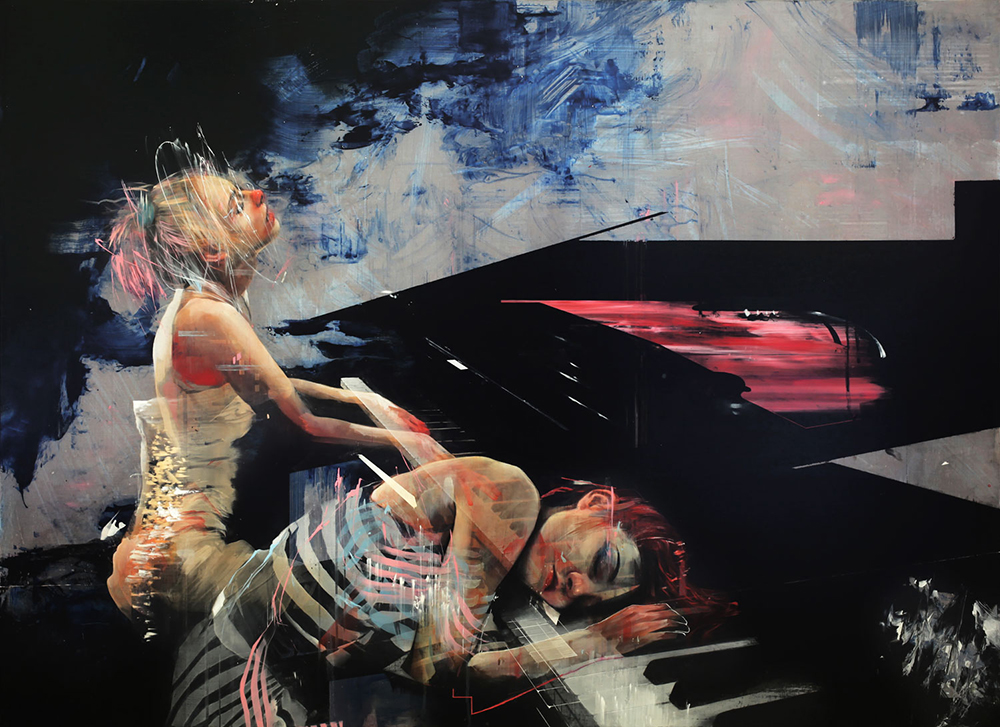“Artificial Winter” the new show by UK-based artist Ian Francis, shows his sharp interest in distorting and abstracting the natural world. Francis’s artwork doesn’t shy away from brutality. He creates images of pornography, of death, and of violence. He paints with an incredible amount of technical ability, from which he floats away from in a color palette of abstracted pinks, yellows, and blues.
“Artificial Winter” is the perfect encapsulation of Francis’ style: harrowing images masqueraded by a bubble gum palette. In paintings like “Piano Duet Collapse” we see a young woman collapsed on a piano, slowly fading downwards into translucence. As she fades we see her bones underneath, which have been stained pastel pink and blue.
I sat down with Francis to discuss “Artificial Winter,” podcasts, and the nature of his paintings as being “removed from reality.”
First off, I want to say congratulations on your upcoming solo show “Artificial Winter” at Corey Helford Gallery! Can you tell us about the name of the show?
Thanks! I think I first heard the phrase ‘artificial winter’ in a science podcast where people were discussing global warming. It was interesting in the way it was initially meant, but something about the words stuck with me beyond the original context. I think it’s the impossibility of controlling the order of the real physical world in such a way, but that we spend such an increasing amount of time in unreal/non-physical spaces that ideas like this start to have a meaning.
I love your painting for the show titled “Two Mannequins Wash Up On The Shoreline,” what ideas influenced this piece?
I’m interested in the idea that people put so much effort into creating images of themselves at the moment, and then they exist out there somewhere, independent of their creators, timelessly. Even though people change their looks, or change their friends and relationships as they’ve always done, the old discarded images of themselves continue to exist out there somewhere. That’s what led to this image of shell like people washed up on a deserted beach somewhere.
You’ve described your paintings as being “about pornography and news reports from war zones rather than sex and death” – what do you mean by that?
I meant that they were a step removed from reality, that my work is about the representation of those things and how those representations affect me, rather than those things affecting me directly.

‘Vacation Resort Conversation Exit’
Many of your paintings deal with technology, and seem to blend natural colors and forms with artificial ones. Can you tell me a bit about this contrast?
I like the contrast between the organic and the technological. I try and evoke that by exploring both the organic way people are constructed (with elements of paintings sometimes having the skeletal structure visible through a translucent shell), and the way digital images are constructed, with painted abstractions echoing types of digital corruption and glitches you sometimes get. I’m interested in the way technology shapes us and makes the world strange, and the way it can start to fall apart.
Can you tell us about the process of your paintings from the original idea?
I look through thousands of photos on the internet from lots of different place, and save anything and everything that I find interesting into folders on my pc. From time to time, I flick through these folders, and look at the way ideas recur in different places, or link together. I make roughs in Photoshop, which can vary between very precise detailed plans and very loose things that are just a fragment of an idea. Sometimes I start painting immediately, other times things stay as roughs on the computer and get developed and revisited months or years later.
Once I start painting, I go back and forth between the painting and the computer, photographing it and putting it back into Photoshop to play around with ideas. Sometimes the final piece looks a lot like the initial idea, and sometimes it goes somewhere completely different.
Who are some artists that made you initially want to pursue a career in the arts?
I was into fantasy/sci fi art a lot when I was a kid. When I was a student at university, it was Dave McKean with the Sandman covers and Stanley Donwood with the Radiohead album artwork that made me want to make the kind of work that developed into what I do now.
What music were you listening to while making “Artificial Winter?”
I’ve not actually listened to enough new music lately. Recently I was listening to old Fecal Face music podcasts from 2005-7, but there’s some great podcasts out there at the moment like You Must Remember This, Kermode and Mayo’s Film Review, Politico’s Nerdcast, Twin Peaks Rewatch – I should really search out some good new music, I haven’t for a while.
Thanks so much for sitting down with us, and what can we expect from you and your art down the road?
I was actually just looking at some roughs of ideas, there are so many paintings I’d like to make at the moment. I think I’d like to make some work at a larger scale, to see how it changes the impact or immersion of a piece. I should also probably do something for my wife, there’s a piece I started for her about 5 years ago that I still haven’t finished!
Ian Francis’ show opens at Corey Helford Gallery in Downtown Los Angeles Saturday, October 28th.

‘Minotaur Ossuary Disaster’

‘Piano Duet Collapse’

‘Pouring Structure
